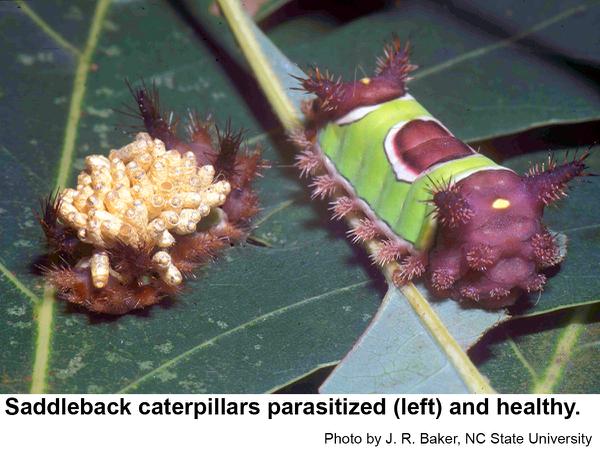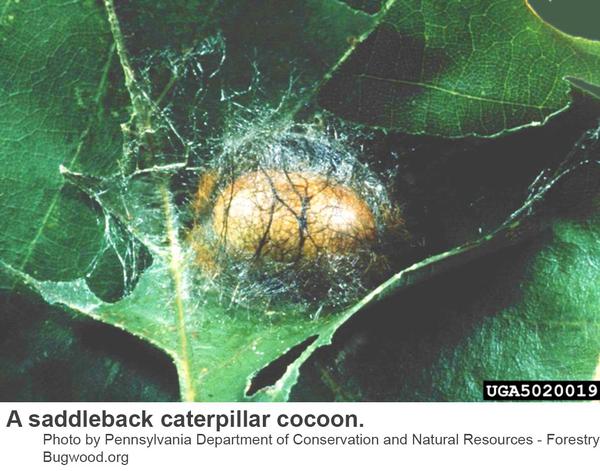Description and Biology
Saddleback caterpillars, Acharia stimulea, have a brown saddle-shaped spot on the middle of their green backs. They are called slug caterpillars because the abdominal legs lack tiny hooks that most other caterpillars have, and because the six jointed legs are so short. Saddleback caterpillars are one of the stinging caterpillars that bear urticating hairs on four prominent knobs at the front and rear as well as smaller knobs along the sides. These caterpillars are about 3/4 inch long when mature and spin tough silk cocoons in which they overwinter. Saddleback caterpillar moths are fuzzy and dark brown with some cinnamon spots and tiny white spots. These moths emerge from the cocoons the following spring and summer and lay 30 to 50 tiny, flat eggs that overlap like fish scales on the upper surface of leaves of various trees and shrubs. From the eggs hatch tiny, almost transparent caterpillars that already display yellow, spine-covered knobs around their bodies. Aside from tiny parasitic wasps that plague saddleback caterpillars, other mortality factors such as diseases and predators usually keep the numbers of these caterpillars low.
Host Plants
Host Plants Saddleback caterpillars feed on a wide array of trees, shrubs, and crops where they do little harm except to the occasional person who accidentally brushes against one. They have been reported feeding on more than 40 plant families and numerous species within those families.
Residential Recommendations
Those pesticides labeled for landscape use should give adequate control. In the landscape saddleback caterpillars normally occur in very low numbers and may be controlled by dislodging and trampling underfoot. Some people are very sensitive to such stings and may require professional medical treatment. Saddleback caterpillar stings cause immediate pain that then spreads to nearby lymph nodes. Swelling and redness can last over a week. Wash the site immediately to remove any loose spines and allow it to air dry. Any remaining spines can then be removed with an adhesive such as duct tape. Not handling caterpillars that have spines is one of the best ways to avoid receiving stings.
References
- Common name: saddleback caterpillar, scientific name: Acharia stimulea (Clemens) (Insecta: Lepidoptera: Limacodidae). Bibbs, C. S. and J. H. Frank, 2015 (revised). Featured Creatures, Entomology & Nematology, FDACS/DPI, EDIS. Publication Number: EENY-522.
- Stinging Caterpillars on Shrubs. Anonymous. 2020. University of Maryland Extension.
- Stinging Caterpillars. Anonymous. No Date. Florida Poison Information Center - Tampa.
- Insect and Other Pests of People and Animals, 2nd edition. Baker, J. R., C.S. Apperson, and J. J. Arends, editors. 2000. N.C. Cooperative Extension Service publication AG-369. 92 pp.
- Extension Plant Pathology Publications and Factsheets
- Horticultural Science Publications
- North Carolina Agricultural Chemicals Manual
For assistance with a specific problem, contact your local Cooperative Extension Center.
This Factsheet has not been peer reviewed.
Publication date: Jan. 27, 2017
Reviewed/Revised: Oct. 12, 2019
Recommendations for the use of agricultural chemicals are included in this publication as a convenience to the reader. The use of brand names and any mention or listing of commercial products or services in this publication does not imply endorsement by NC State University or N.C. A&T State University nor discrimination against similar products or services not mentioned. Individuals who use agricultural chemicals are responsible for ensuring that the intended use complies with current regulations and conforms to the product label. Be sure to obtain current information about usage regulations and examine a current product label before applying any chemical. For assistance, contact your local N.C. Cooperative Extension county center.
N.C. Cooperative Extension prohibits discrimination and harassment regardless of age, color, disability, family and marital status, gender identity, national origin, political beliefs, race, religion, sex (including pregnancy), sexual orientation and veteran status.




